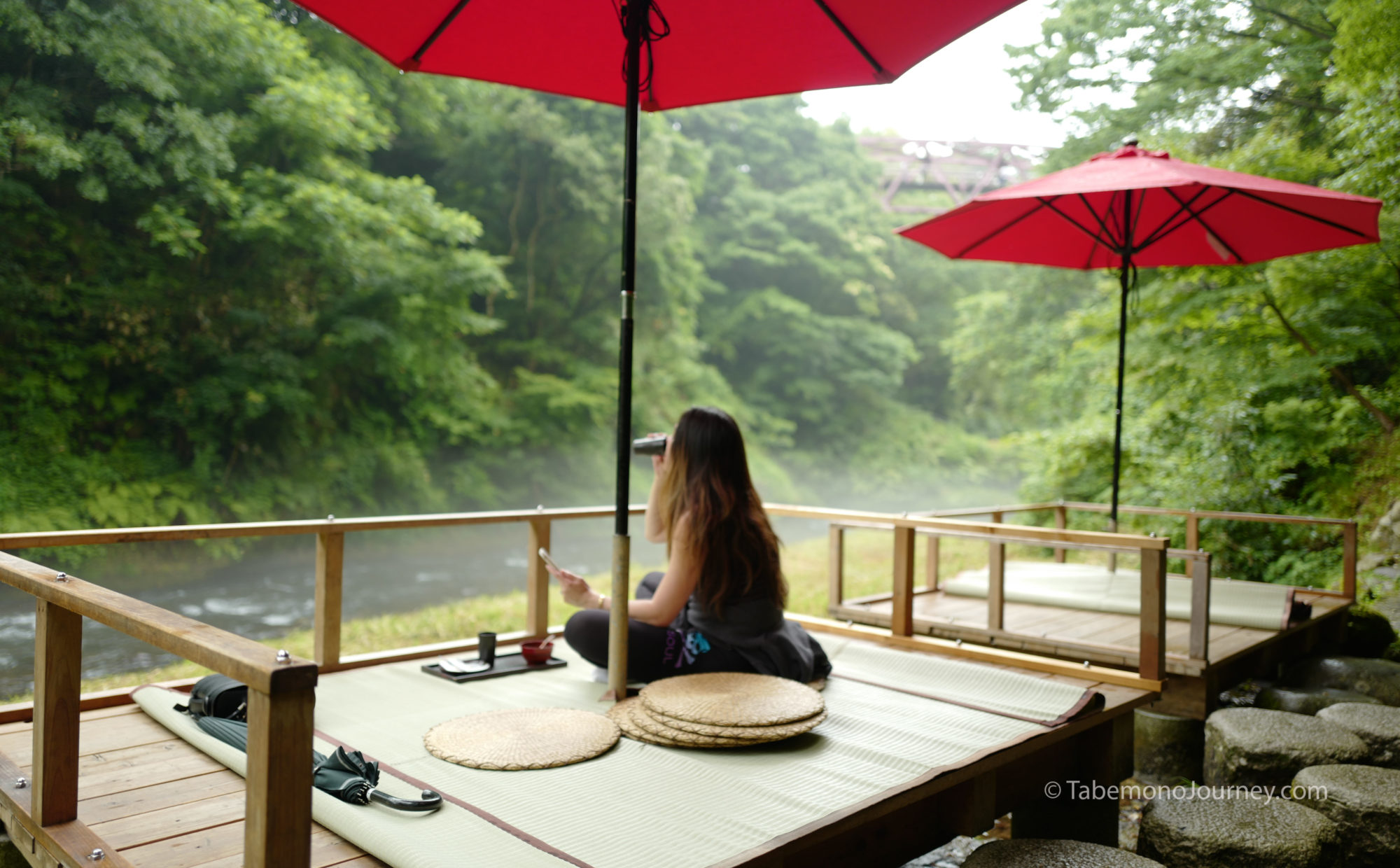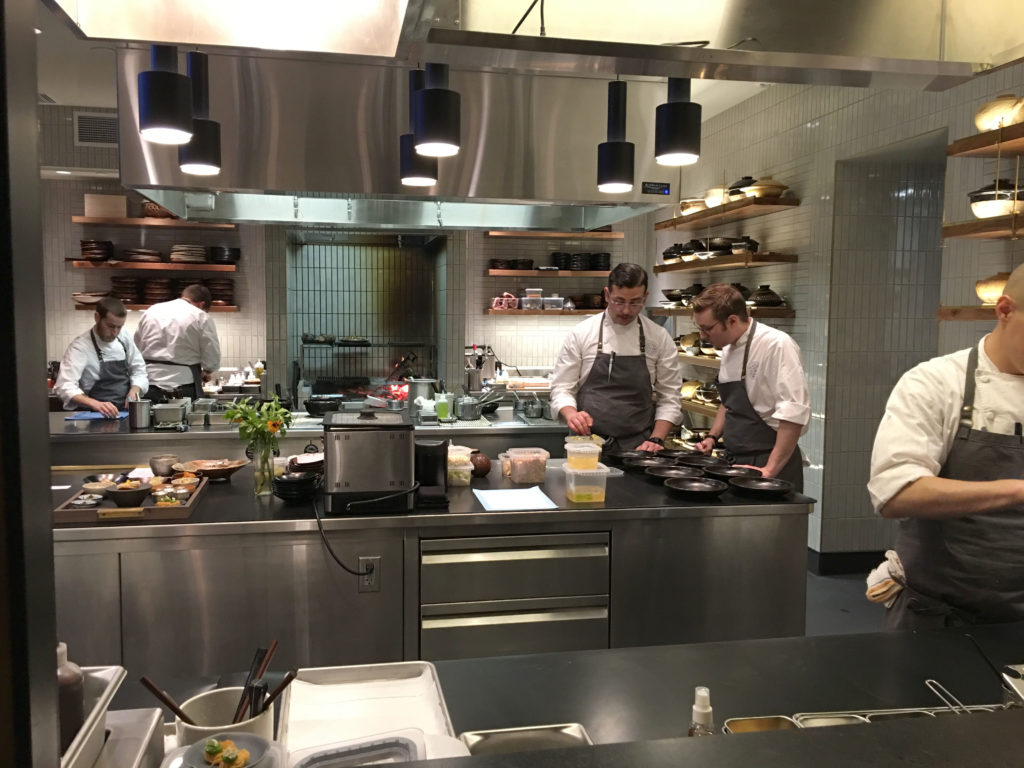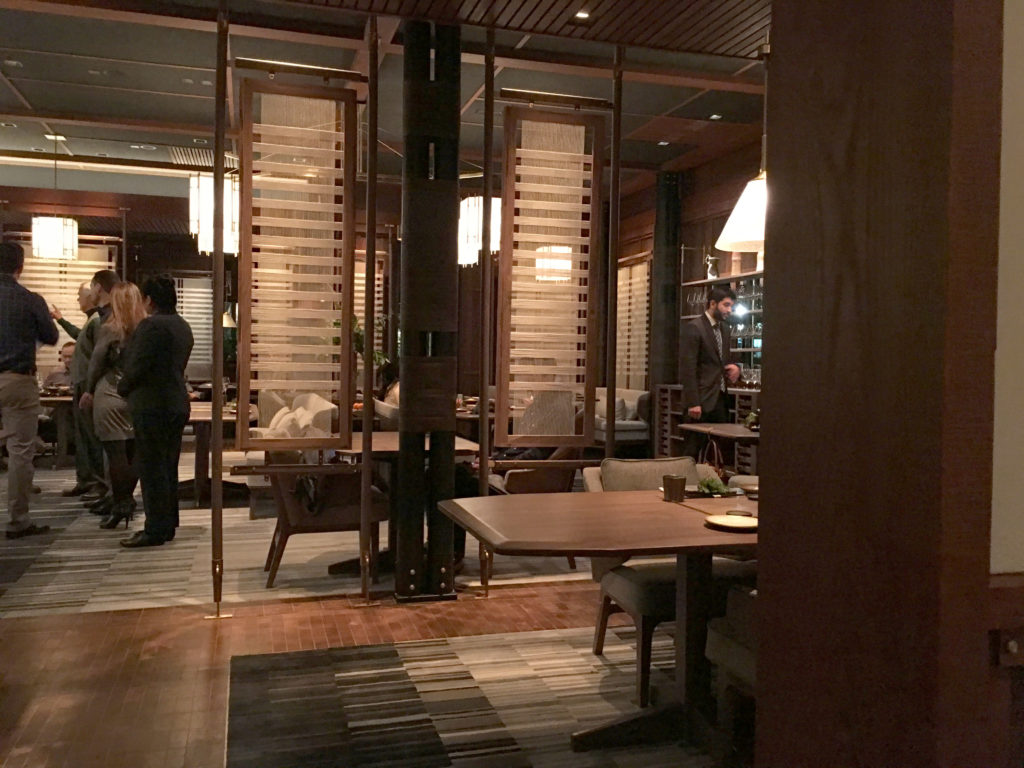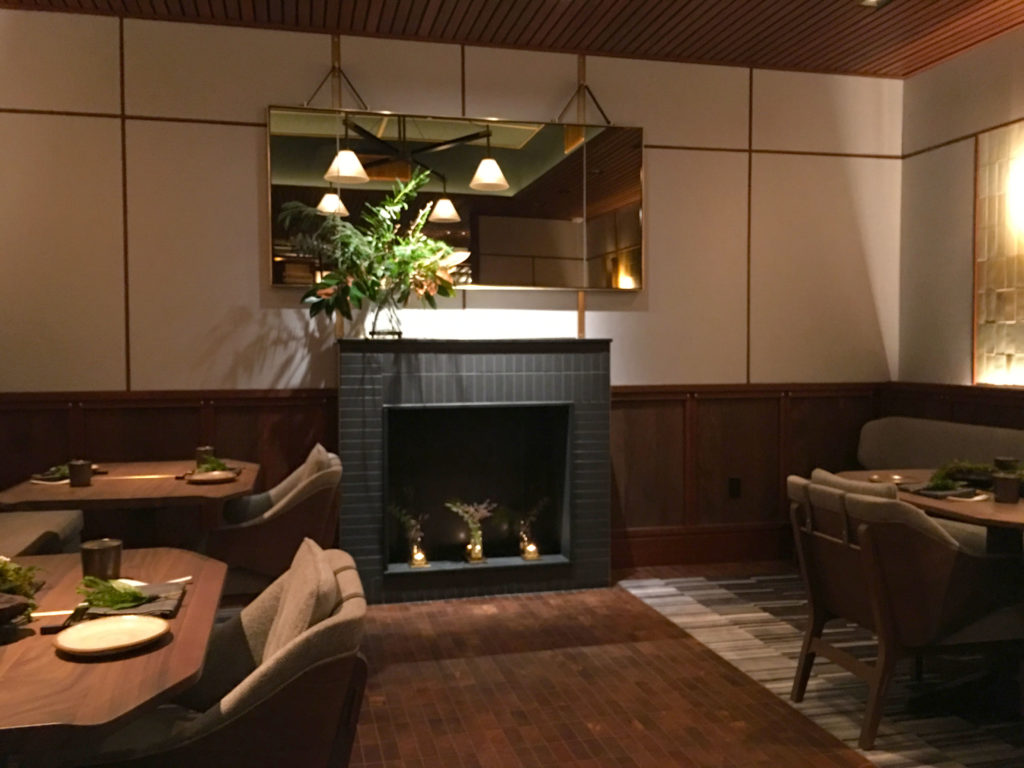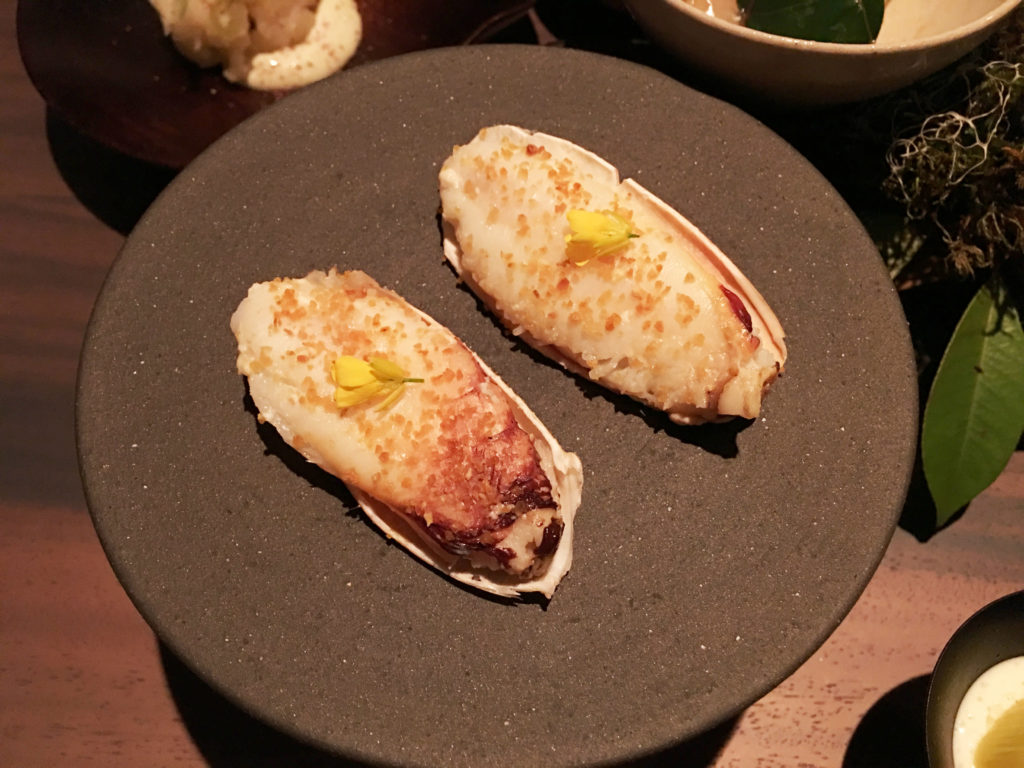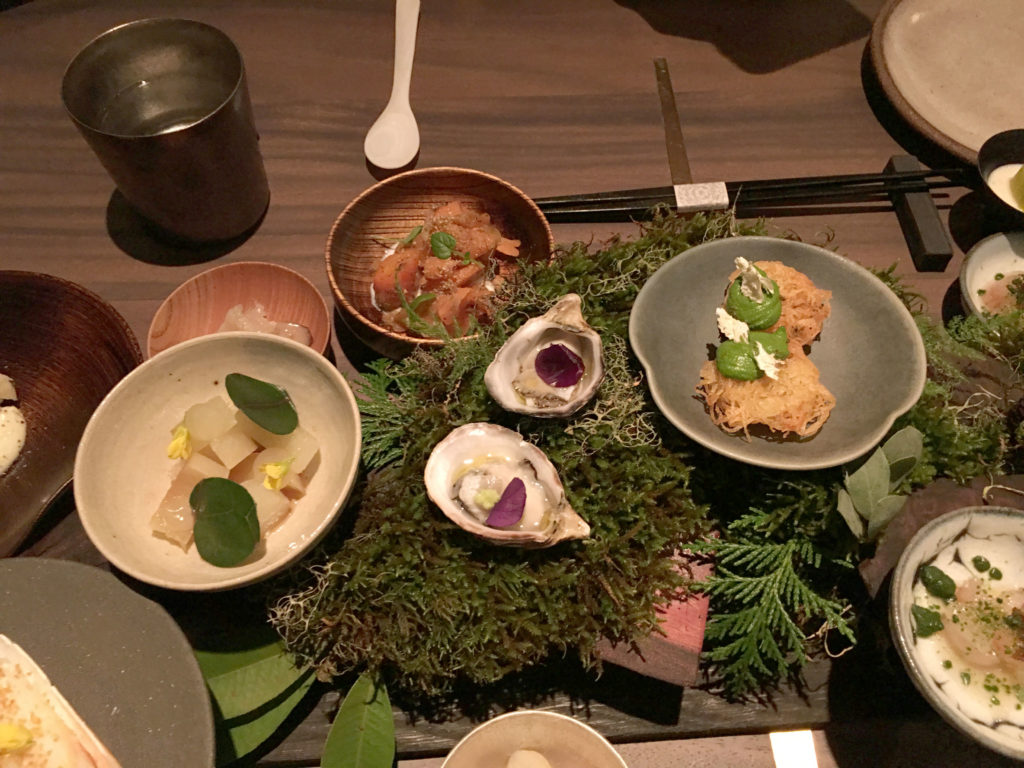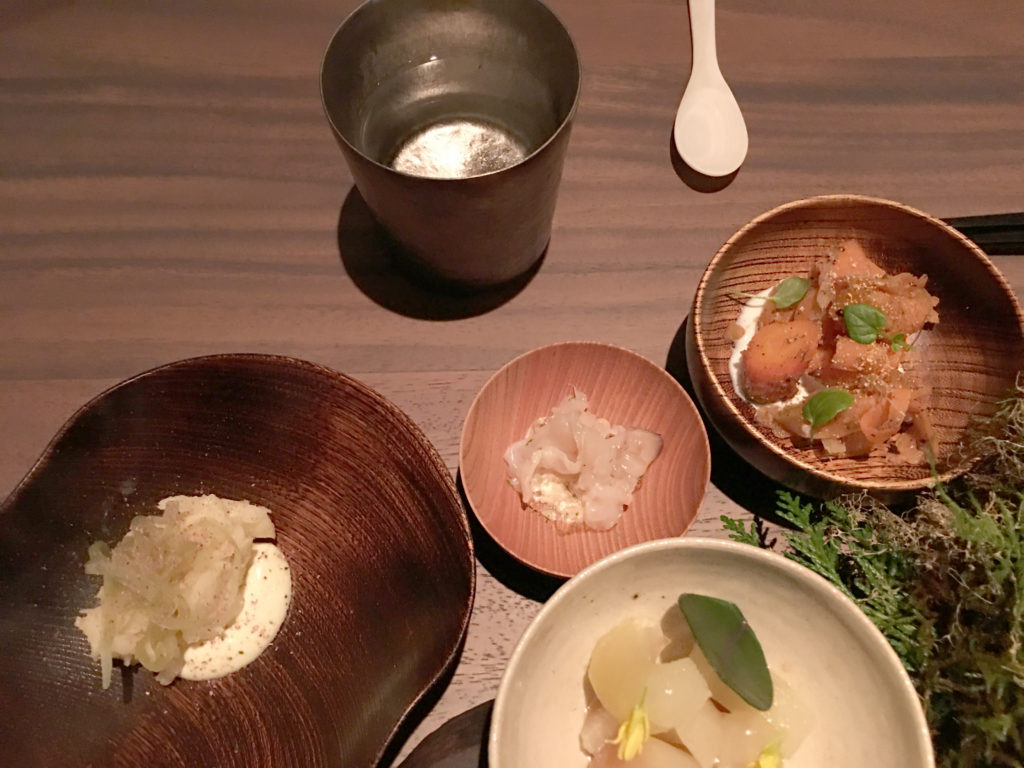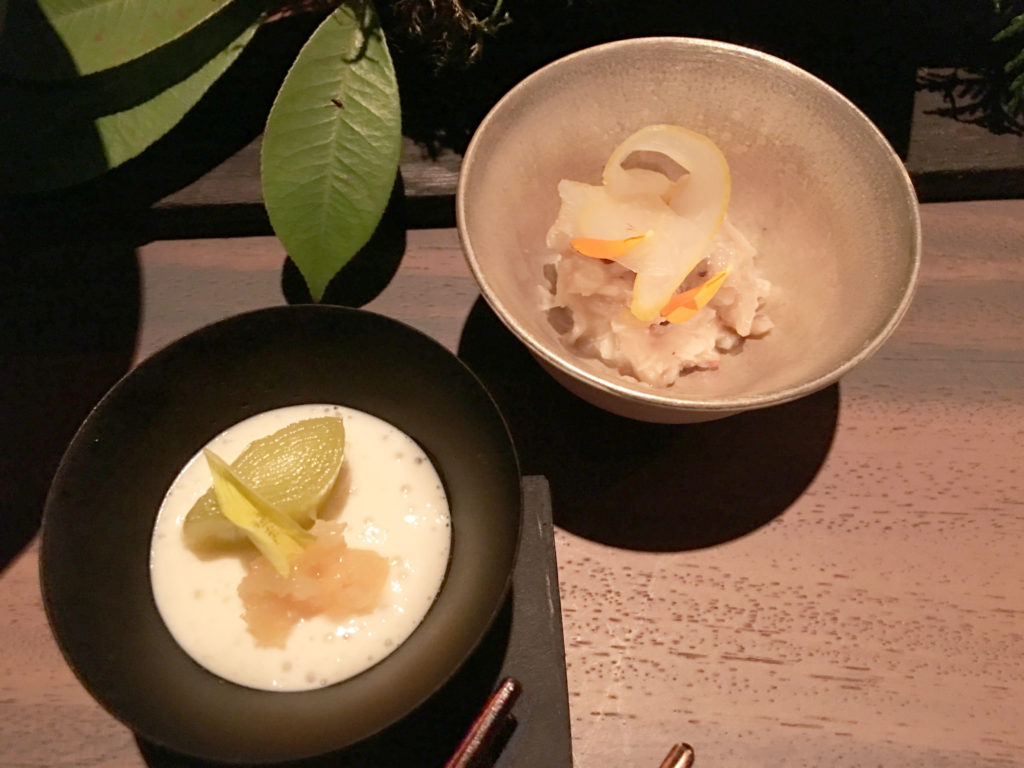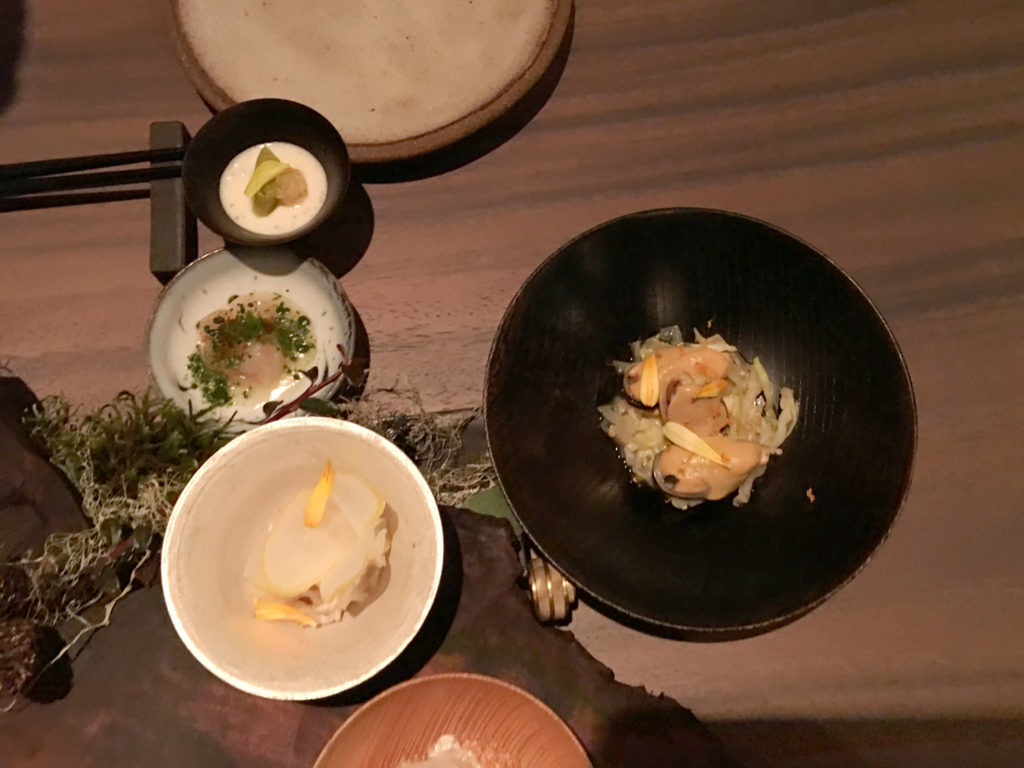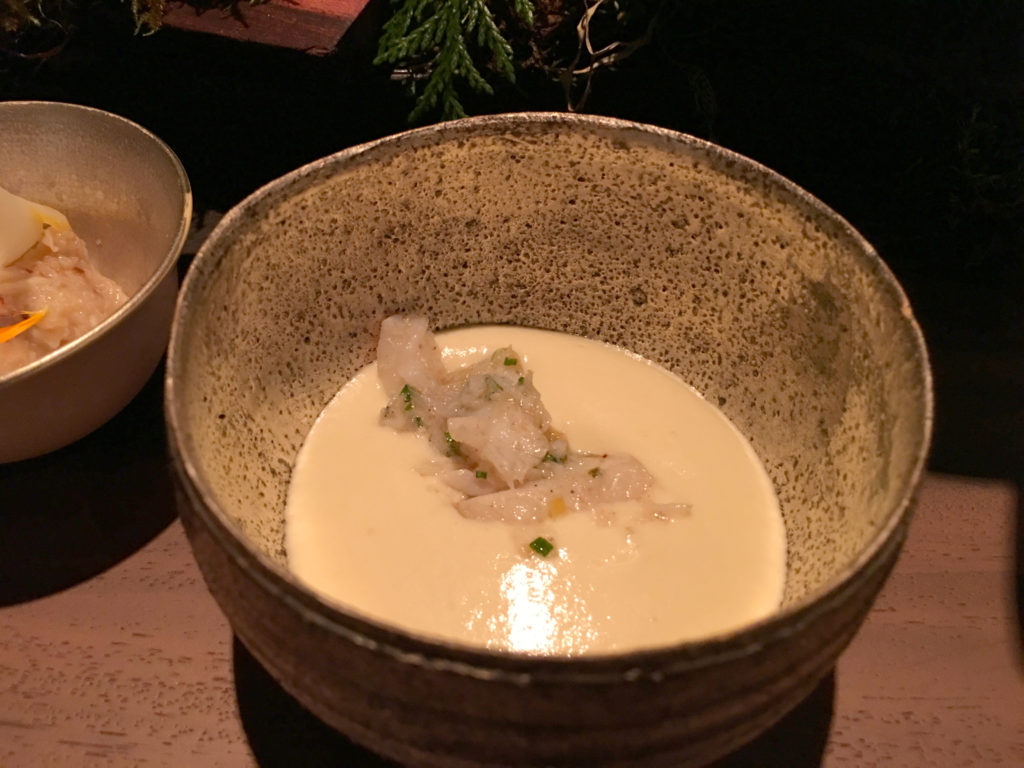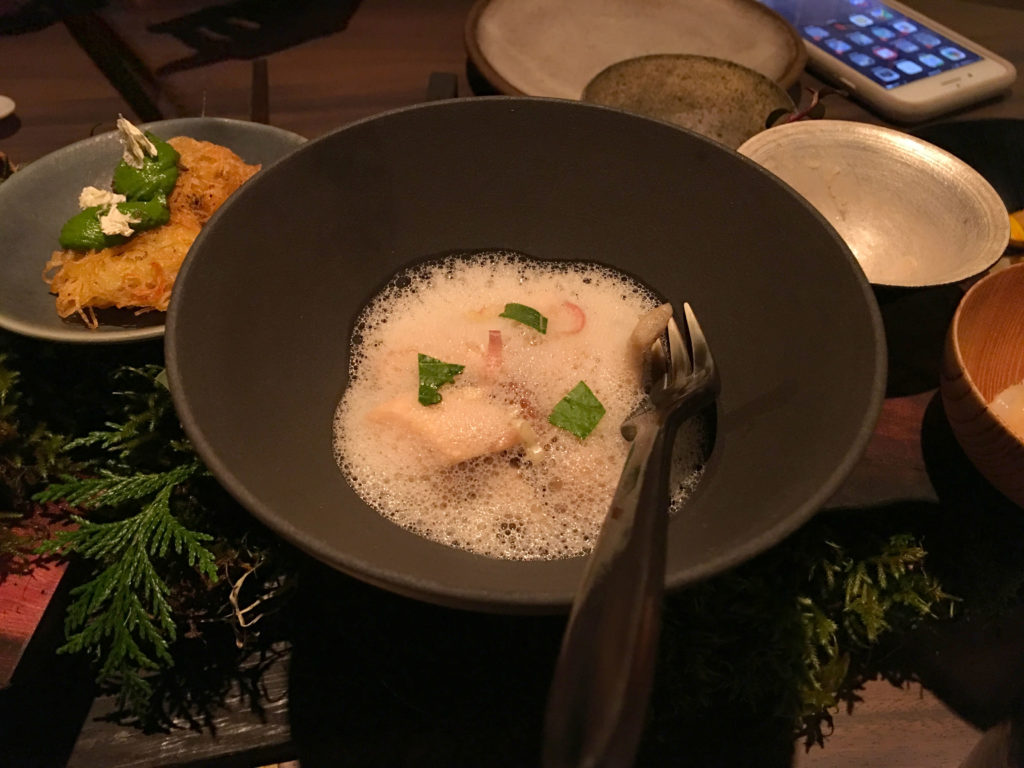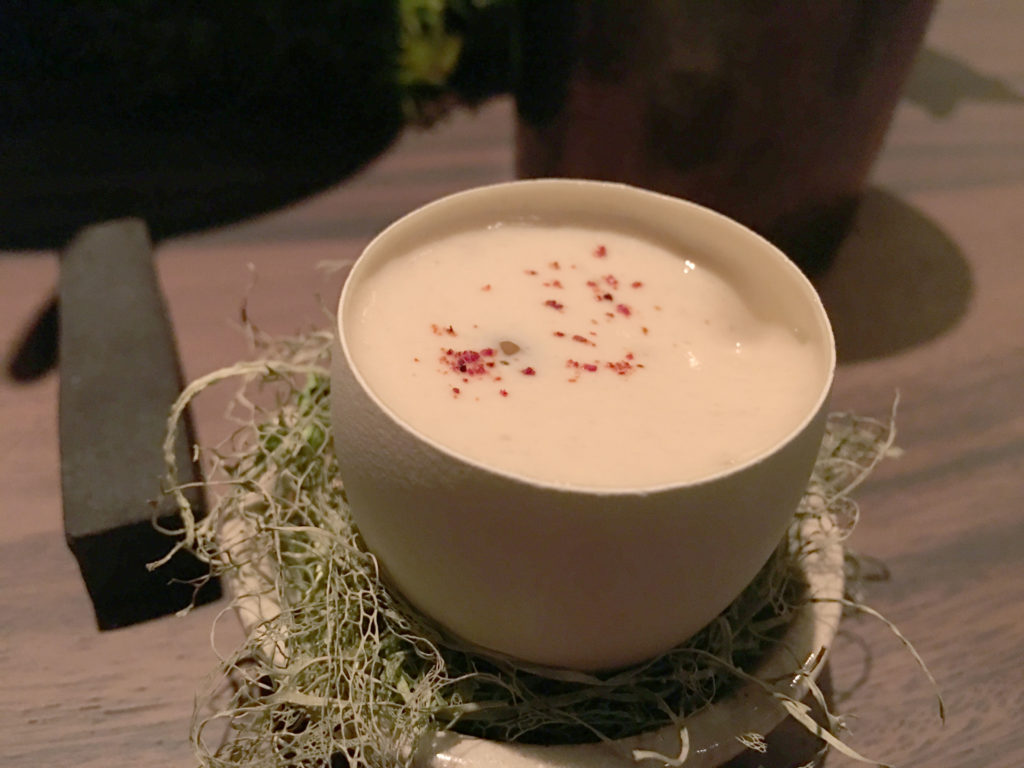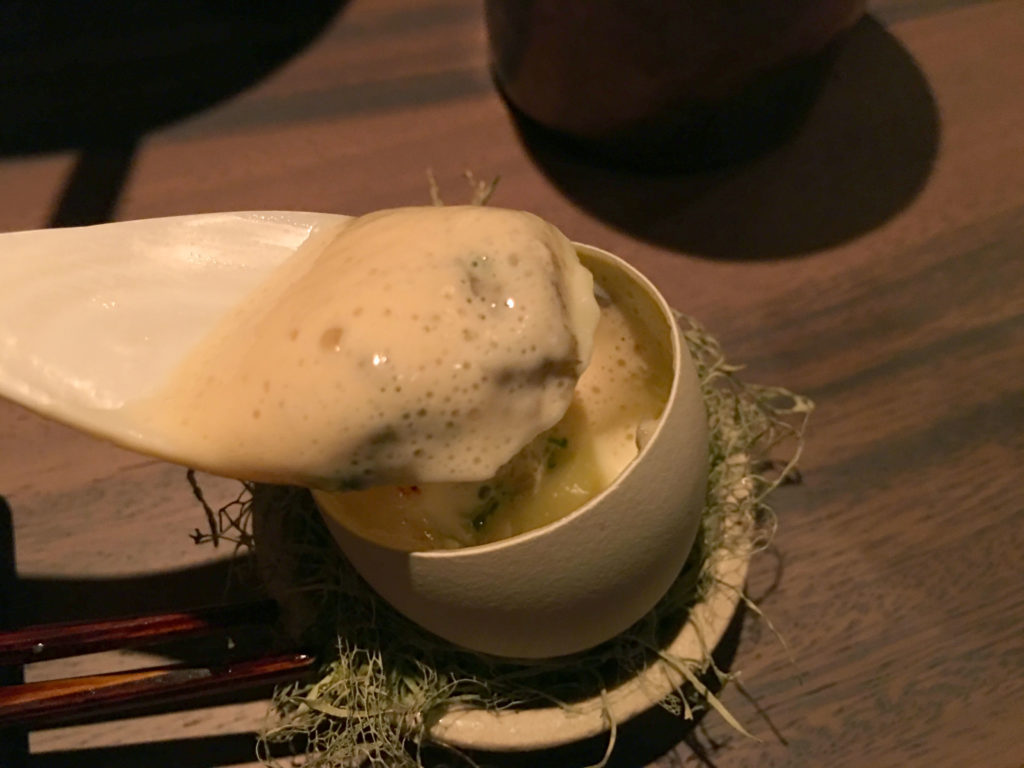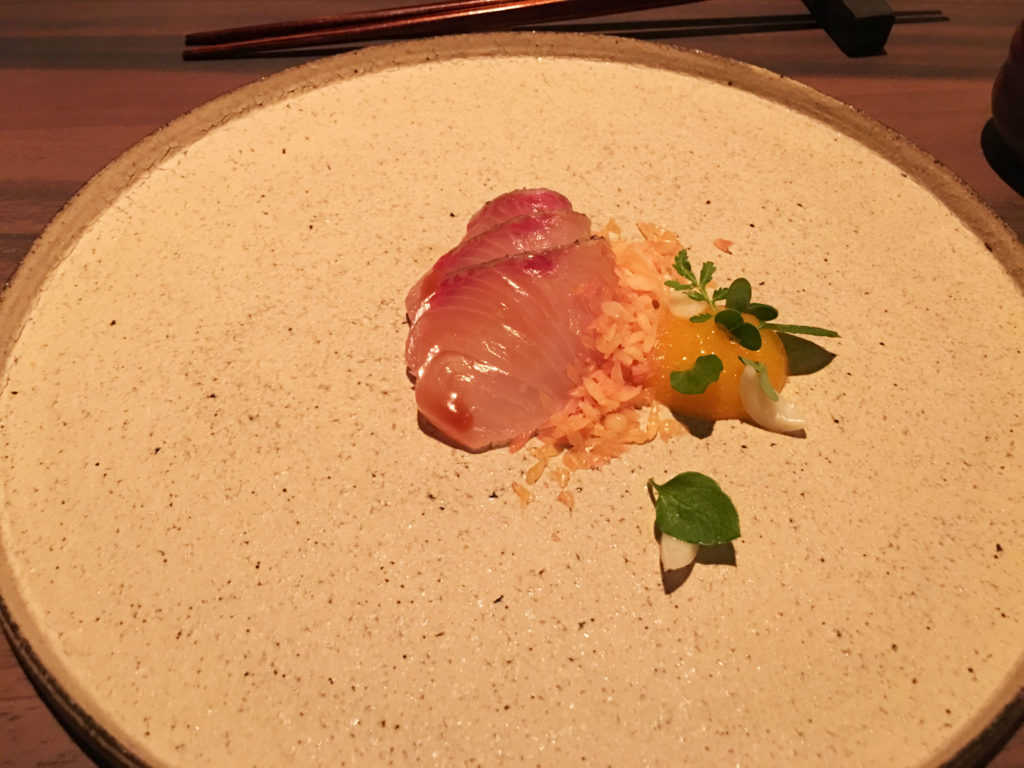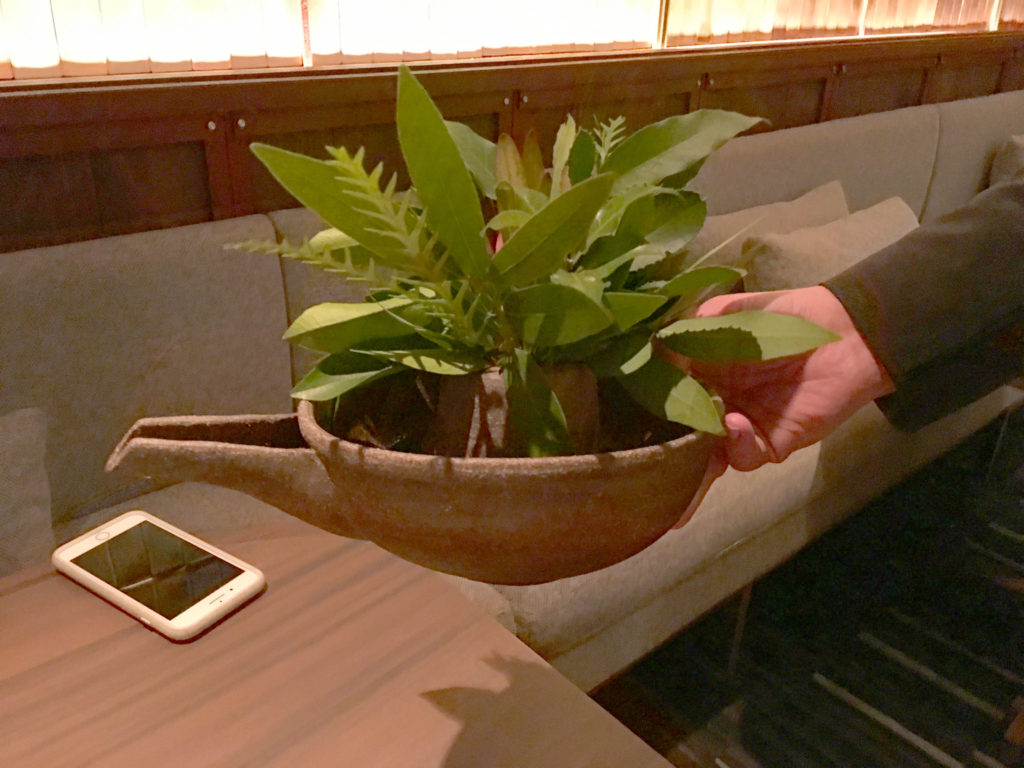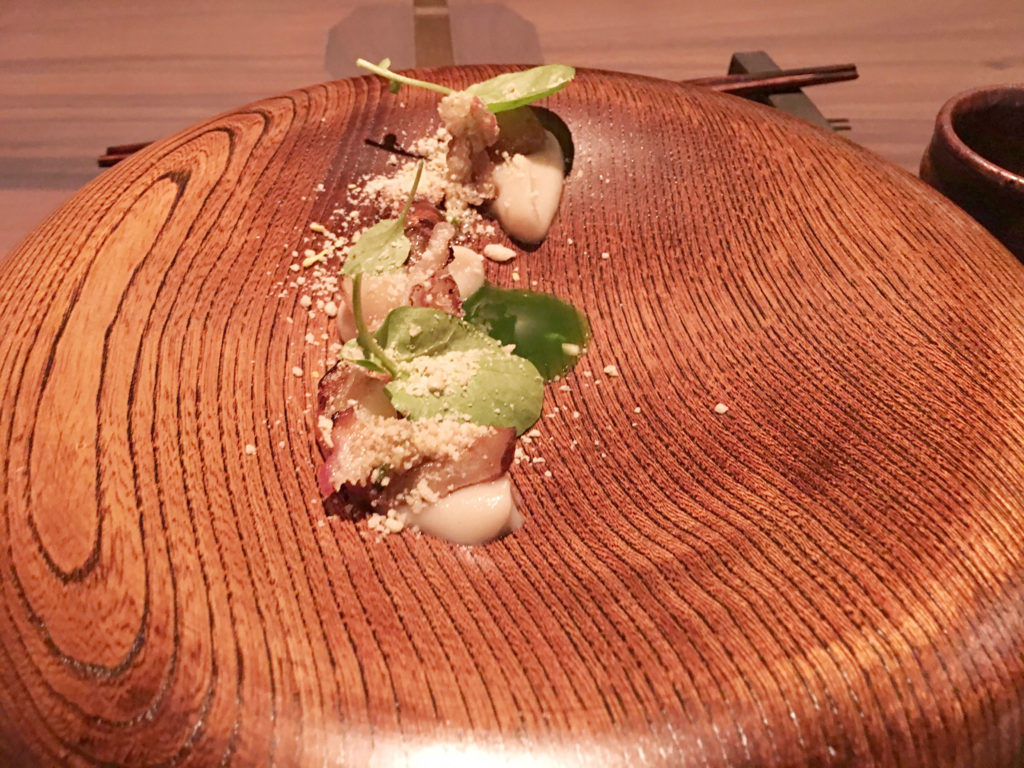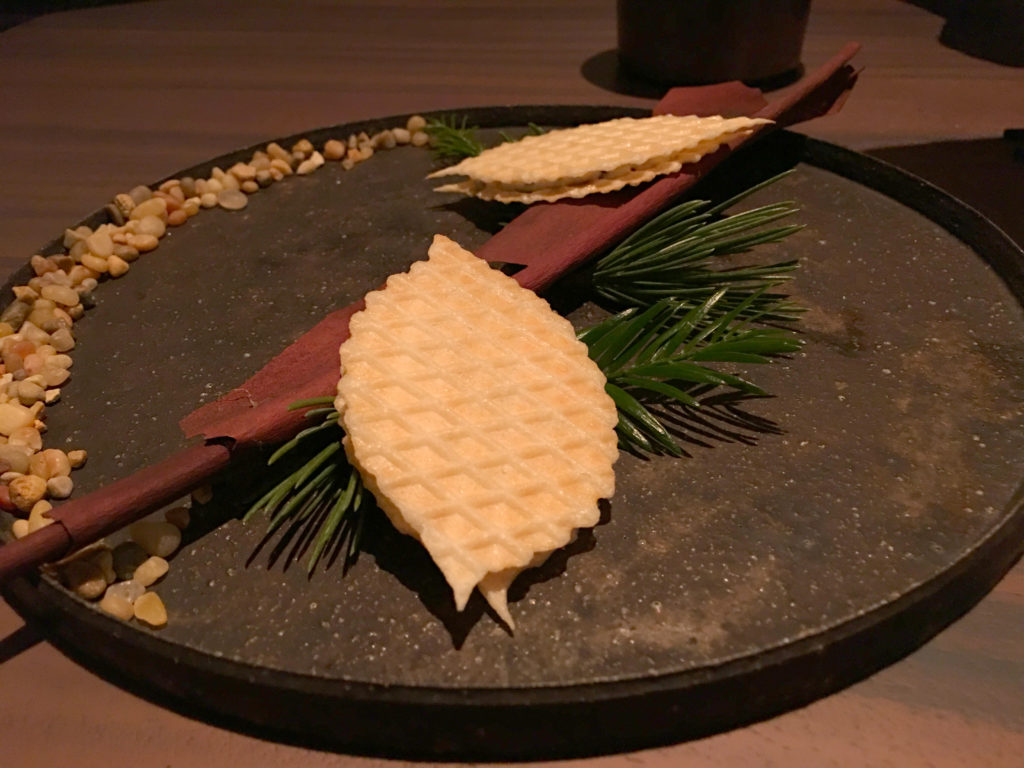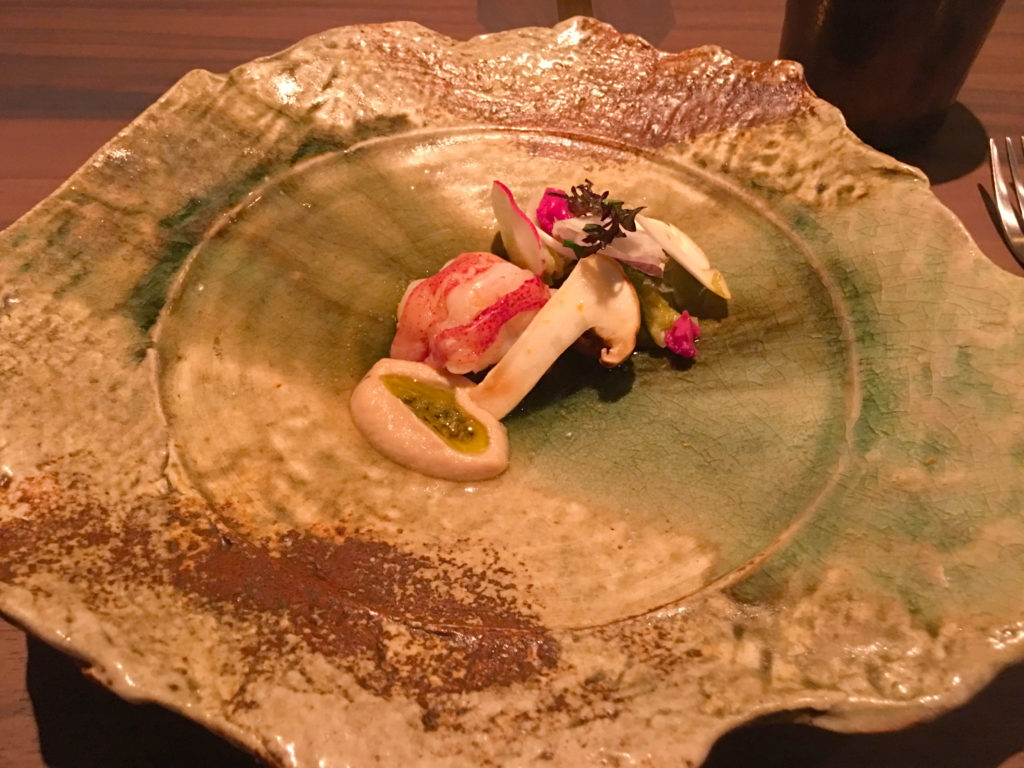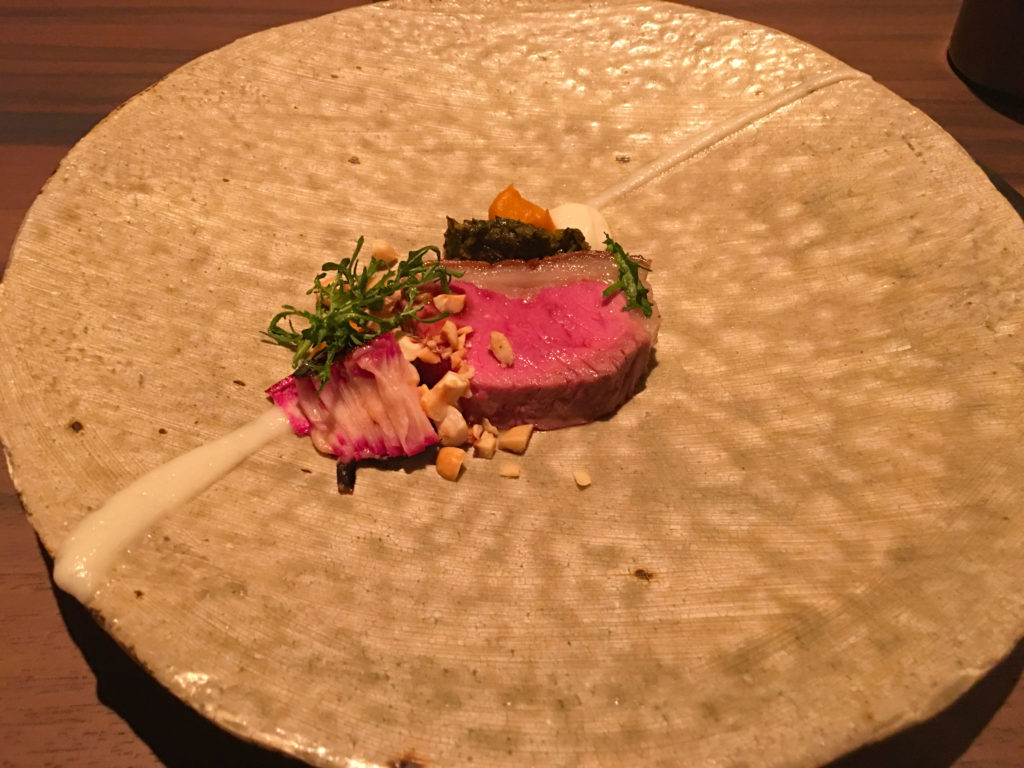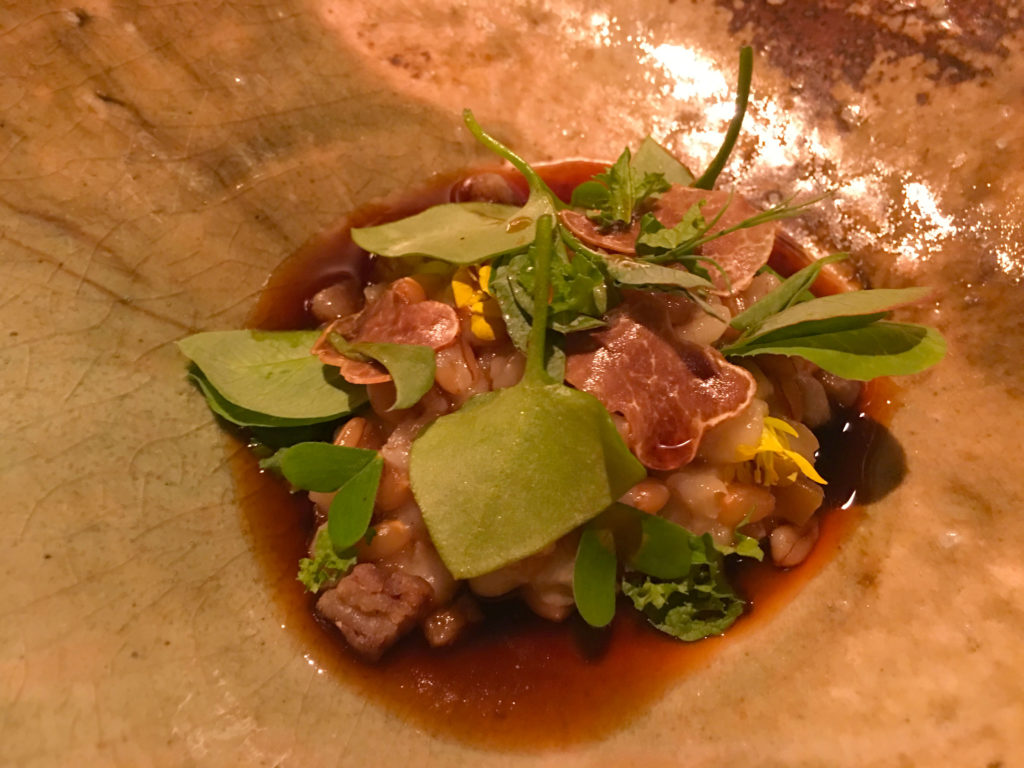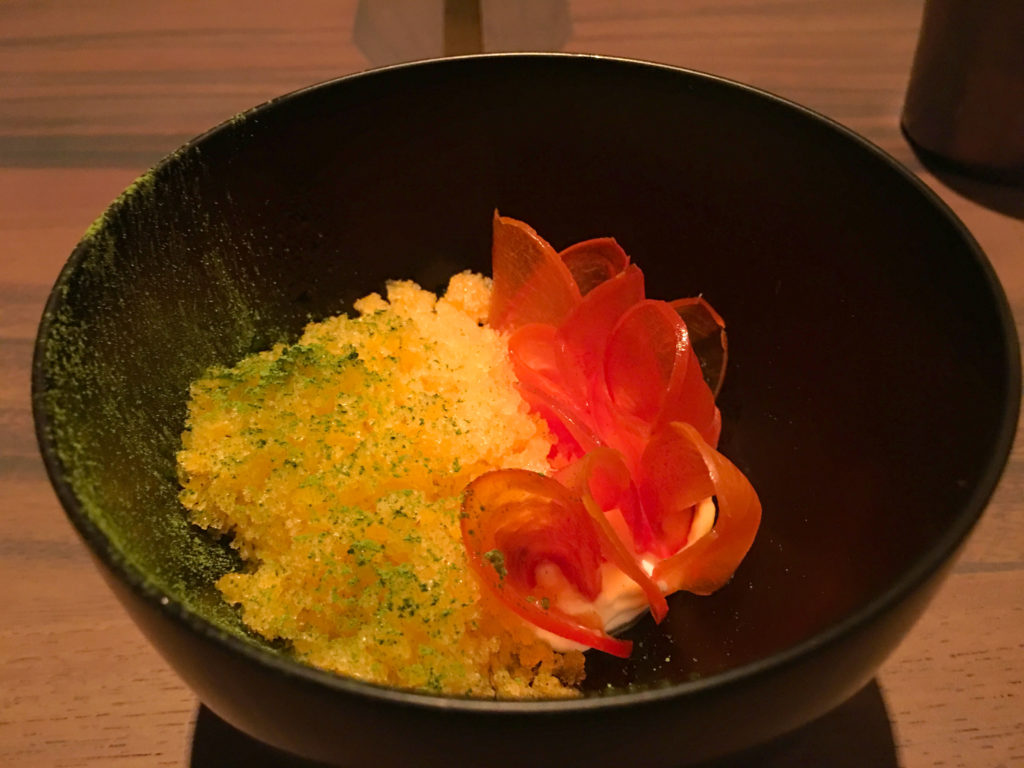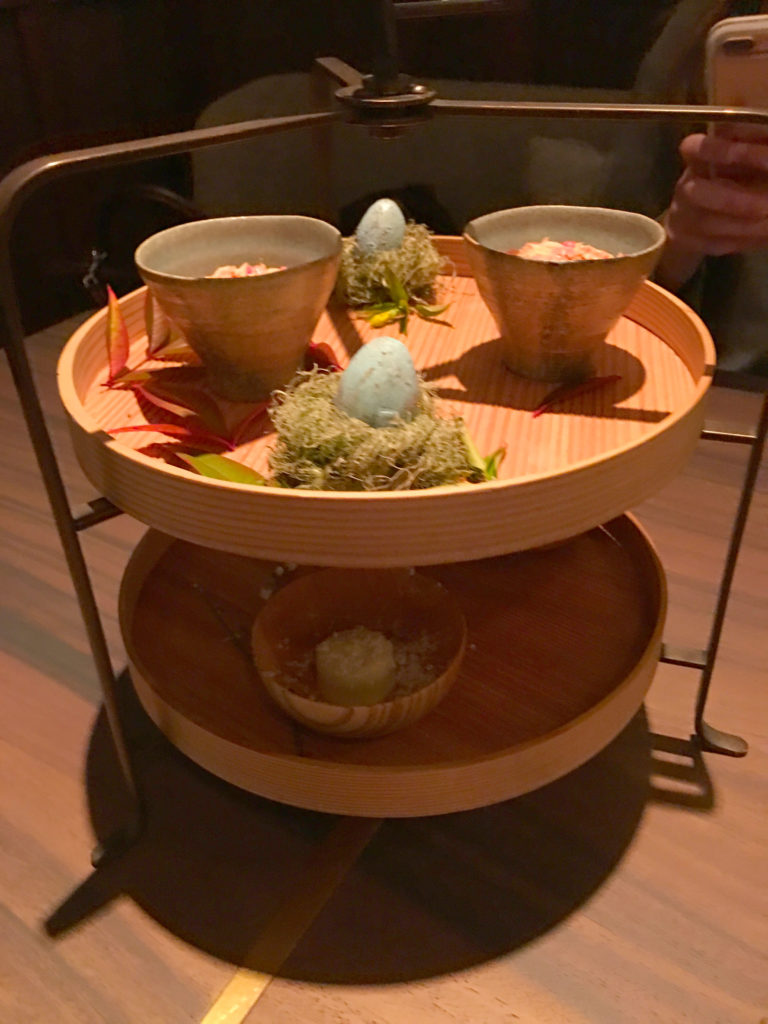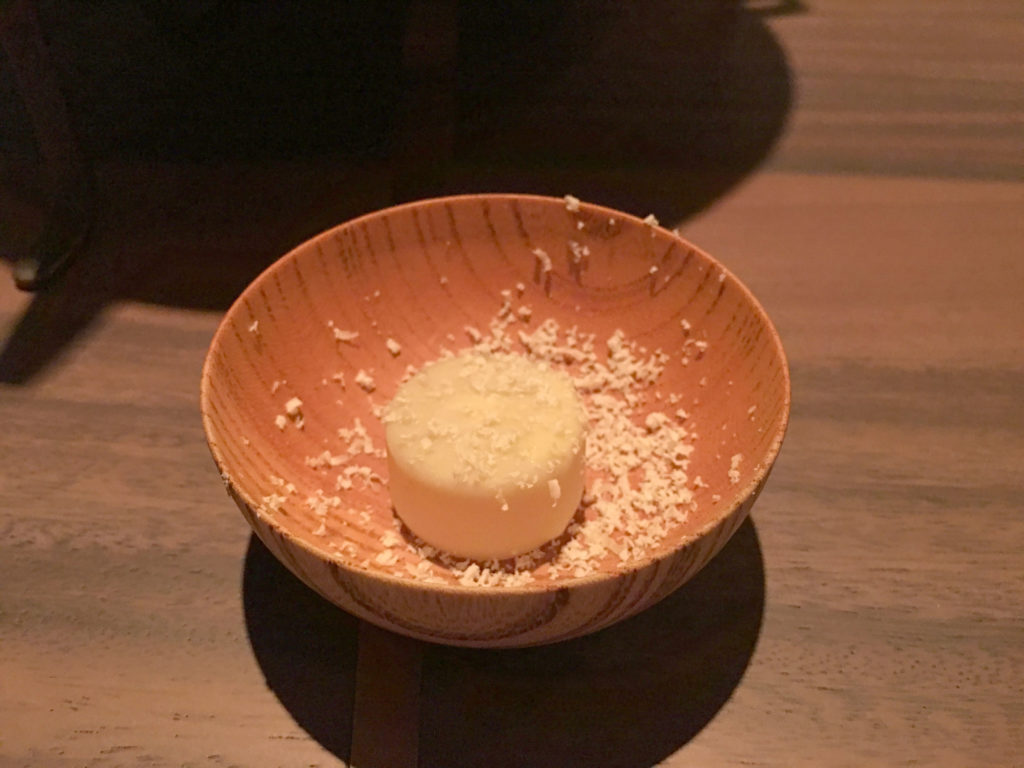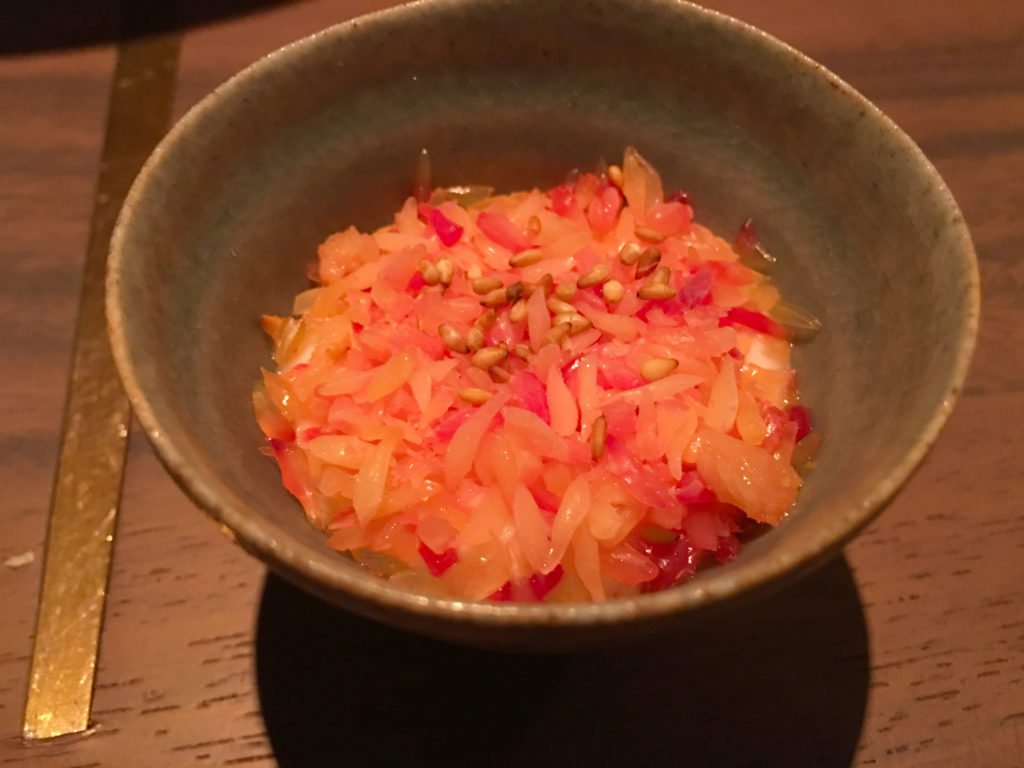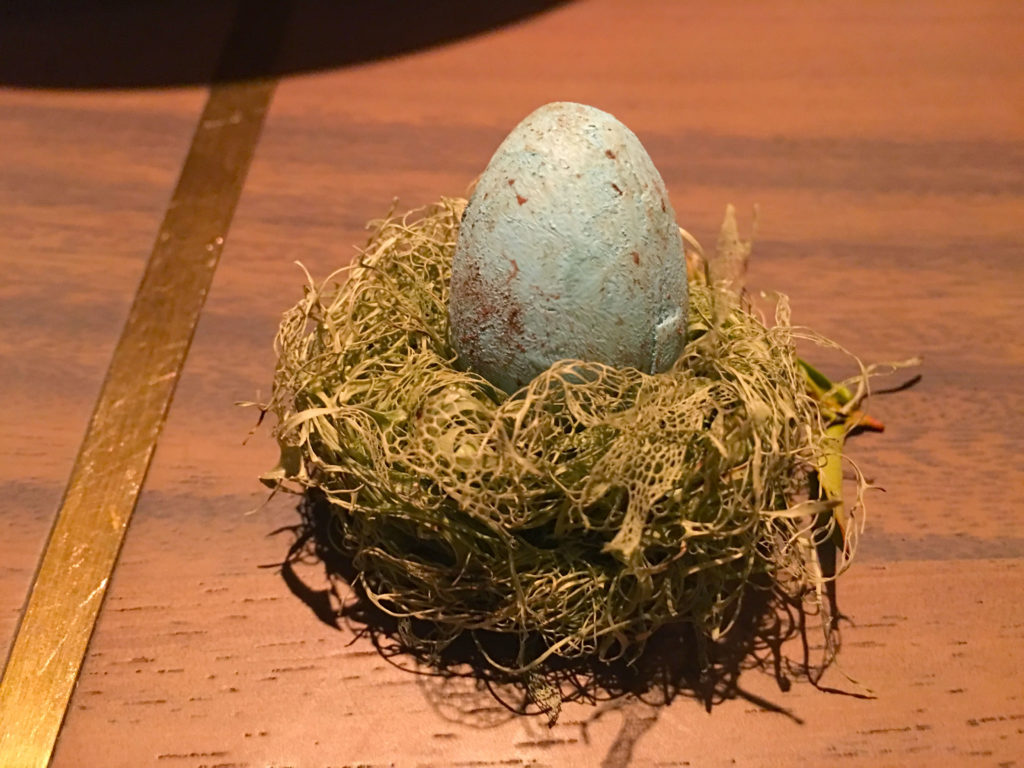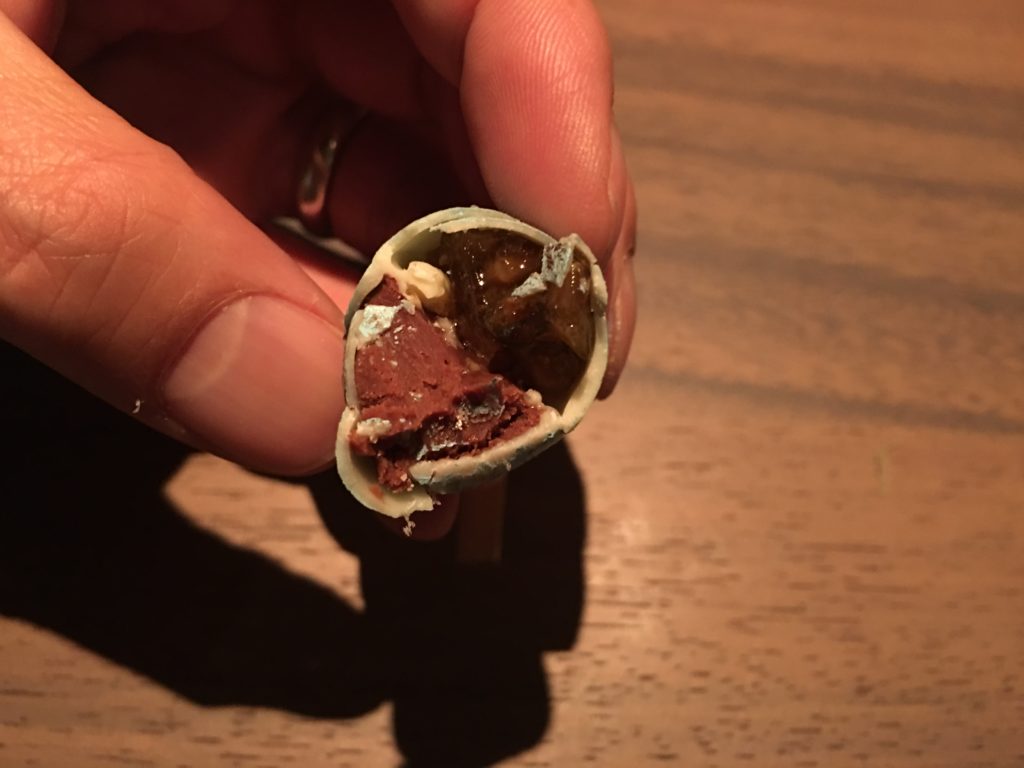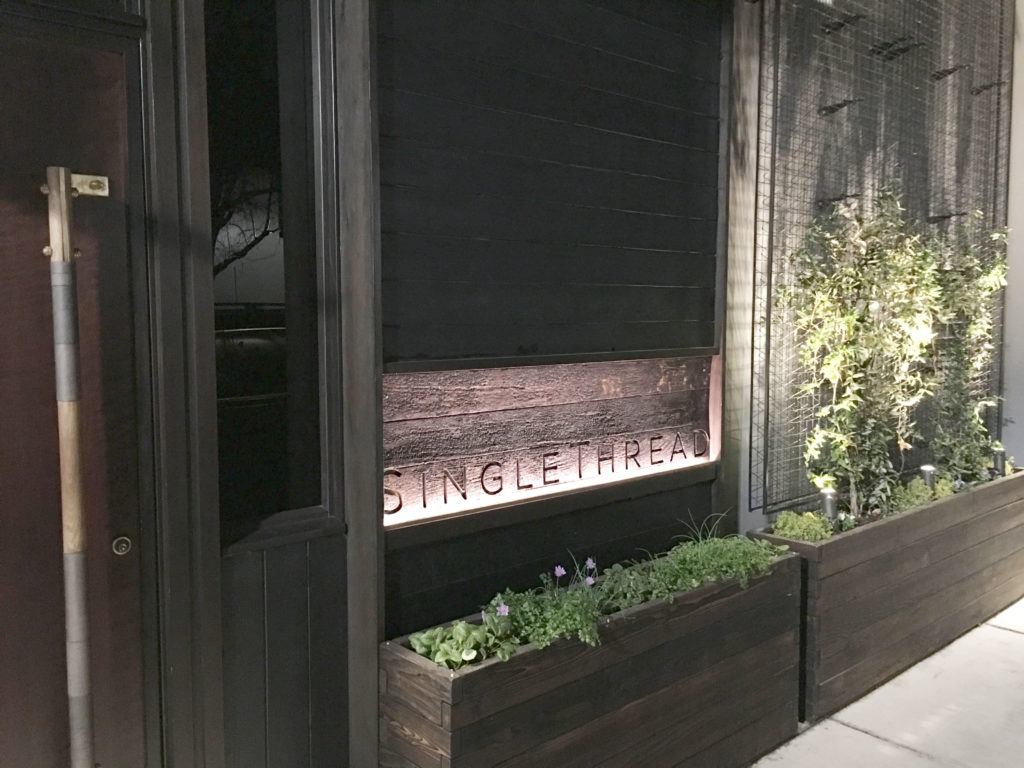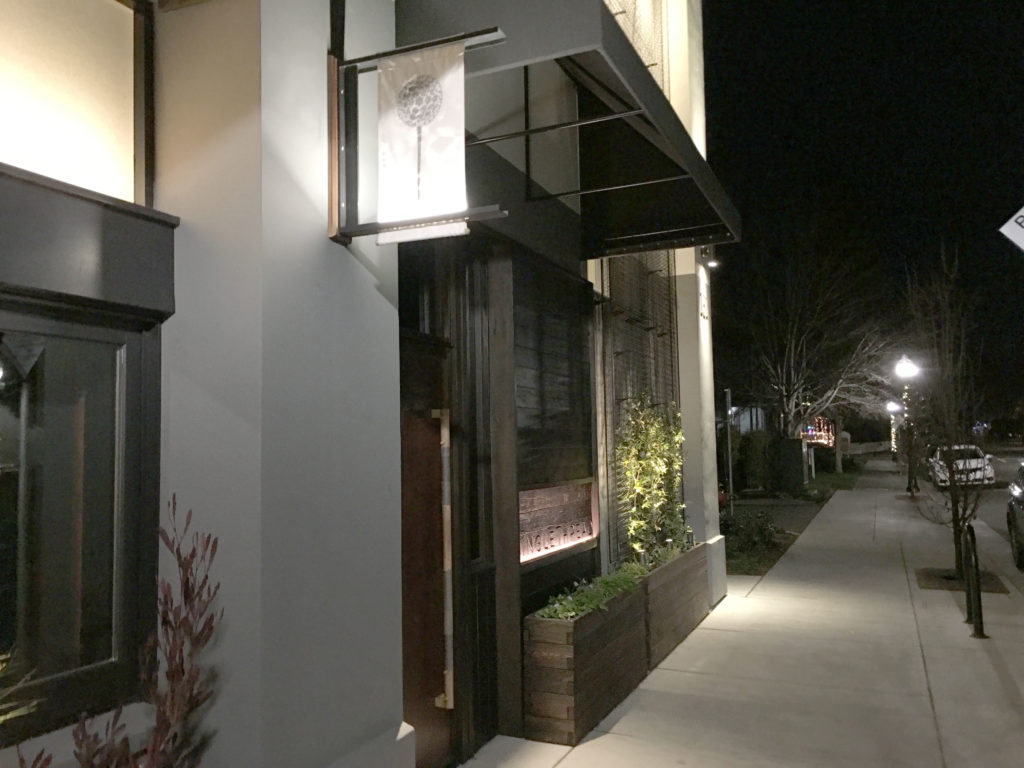
December 30th, 2016
SingleThread is not located in San Francisco, but it is about an hour and twenty-minute drive north in the town of Healdsburg in Sonoma County which is part of the SF Bay Area. Although SingleThread is not a pure Japanese restaurant, it is a heavy fusion of Japanese and California cuisine. You see the deep appreciation of Japan throughout the restaurant, from the origami crane decorations at the entrance to the proud displays of donabe cookware in the kitchen. The ambiance and the food throughout the night gave me that nostalgic feel of eating in Japan. In fact, later that night when we met the chef and owner, Kyle Connaughton, he shared with us that he had previously worked three years at the Windsor Hotel in Toya, Hokkaido. Additionally, I read on their website that a lot of their specialized produce and vegetables will be sourced from their own farm and nearby Sonoma farms. We really looked forward to dinner that night.
If I had to pick a Japanese word to describe the food and dining experience we had at SingleThread, it would be “すごい” (sugoi), which means “WOW!” or as my wife would say throughout the meal “OMG”. It’s a pretty accurate description of what and how we felt throughout the evening as everything was perfectly executed and the food was delicious.
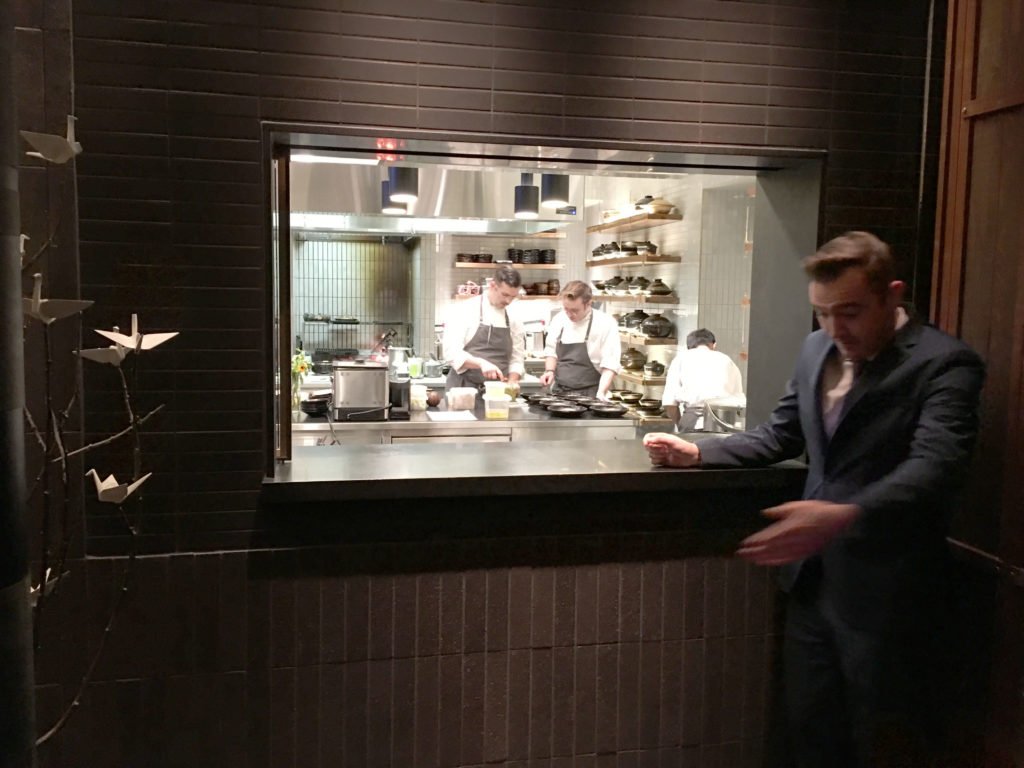
From the moment you open the door, you get a window into the kitchen from the lobby. We were served on the window sill, warm apple cider right after being greeted. Very thoughtful since the cider helps to warm you up as it is chilly outside in December and helps to cleanse the palate.
As we walked from the lobby through the door into the dining area, the kitchen is on proud display, showcasing the work of the chefs and the amazing equipment and donabe pottery in the background.
As we were escorted to our tables, we walked through parts of the dining area and you can see lots of use of wood on the walls and a pronounced double wooden ceilings throughout the restaurant. They also had screens that look like shoji screen panels used in Japan that loosely separated the open dining areas. It gave a modern yet warm feeling.
My wife and I were led to our part of the dining area and you can see beautiful ceramic walls and a fireplace lighted by candles that once again gives you a sense of warmth and comfort for the meal to come.
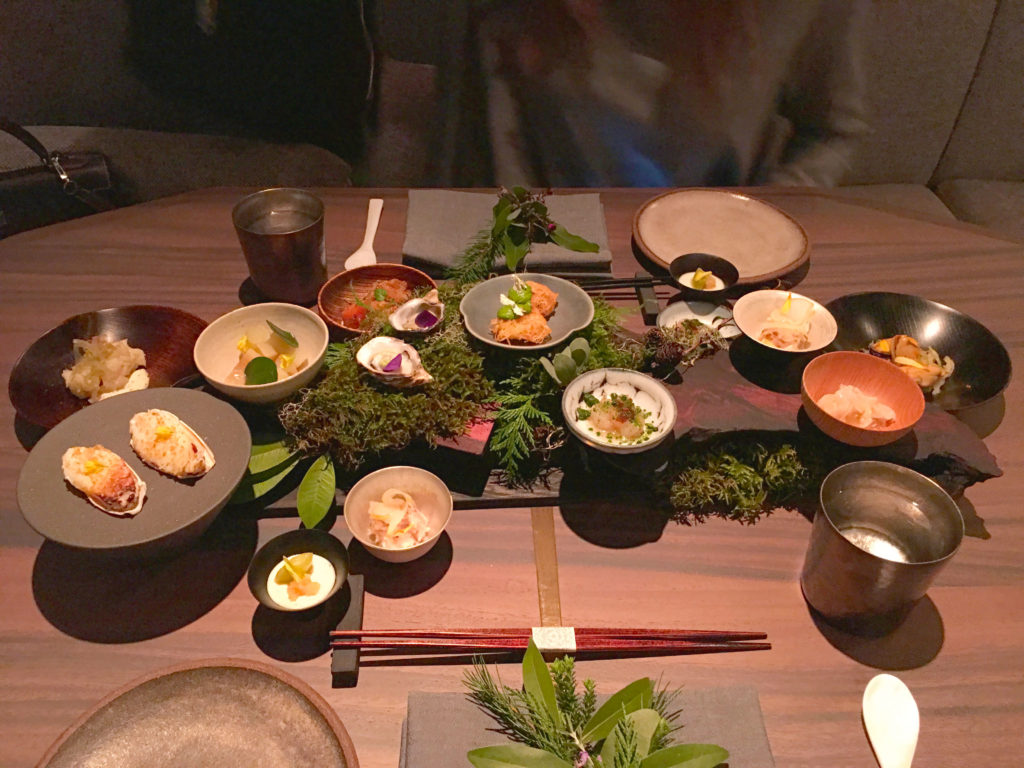 Once we got to our table, we immediately had our first すごい/OMG moment as waiting for us was our first course or more appropriately courses. It was a set of small bites, similar to the Hassun course in a kaiseki dinner. About 10 distinct small bites were gorgeously and proudly displayed using beautiful Japanese earthen and ceramic bowls while the stand used drift wood and foliage such mosses and conifer plants. It was almost too beautiful to touch. However, eating the small bites was a すごい/OMG moment as it tastes as good as it looked. It was an amazing collection of eats that focused on purity of ingredients and plays on textures, while still being tasty . I recalled some items and others I didn’t even know what they were… but here’s a rough attempt.
Once we got to our table, we immediately had our first すごい/OMG moment as waiting for us was our first course or more appropriately courses. It was a set of small bites, similar to the Hassun course in a kaiseki dinner. About 10 distinct small bites were gorgeously and proudly displayed using beautiful Japanese earthen and ceramic bowls while the stand used drift wood and foliage such mosses and conifer plants. It was almost too beautiful to touch. However, eating the small bites was a すごい/OMG moment as it tastes as good as it looked. It was an amazing collection of eats that focused on purity of ingredients and plays on textures, while still being tasty . I recalled some items and others I didn’t even know what they were… but here’s a rough attempt.
Dungeness crab legs were perfectly seasoned and cooked.
From left to right on the three items in the middle – Braised kohlrabi, simmered carrots from their farms, pickled miyagi oysters, fried crispy dumpling (may have been crab)
Next three items with the first i don’t recall, but the middle was a raw mirugai with a citrus seasoning, and lastly simmered carrots from their farm.
Next was a leek dish with a creamy puree and a mashed celeriac dish.
We had a raw spot prawn ceviche, and some pickled mussels, and some root vegetables.
As my wife and I were eating each dish and processing and enjoying ourselves, they would clear some of the dishes away from items we finished eating. Mid-way through, we were pleasantly surprised as our hostess put before us three more dishes.
Here is the first of three additional “surprise” appetizer course. It was a puree topped with something i simply forgot to ask in our surprise.
This was the second addition to the appetizer. It was chanterelle mushrooms and chicken mushrooms in a foam buttery broth.
The third surprise was a light egg course housed in its own egg-shell. Notice the slight blue tone of the egg as our hostess mentioned it’s from their own cross bred chickens in their farm.
It reminded me of a chawanmushi dish at the bottom but buttery on top.
Everything so far was creative and brilliant and we loved every bite. As we finished the appetizers my wife and I looked an each other and we each thought, “すごい” from me and likewise that “OMG” look from my wife as we cannot believe that the main courses had not even started yet and we couldn’t wait.
Our first of many main dishes were slices of kanpachi sashimi. They were glazed with a barrel aged ponzu and paired with cara cara oranges, kansuri, and lily bulbs. The cara cara orange pulps were put in nitrogen, so they simply melted in your mouth as you ate them with your fish.
I ordered the wine pairing and the kanpachi was paired with an amazing junmai sake from Fukushima, but what was more amazing was the earthen vessel it was poured from. Our sommelier shared that a lot of the earthen pottery in the restaurant was custom-made by an earthen master in Iga, Japan. The foliage on top was arranged by the chef’s wife.
Our second main dish were sunchokes paired with sauce of preserved lemon, mangalista jowl, and pine nuts. Mangalista is a Hungarian breed of pork that rivals ibero in its fattiness and is a prized breed of pork.
Next was a snack in between the courses. It was a house made version of a senbei with mascarpone cheese filling. The cracker portion tasted more like potato than the usual rice cracker and really worked well as an intermission to the courses.
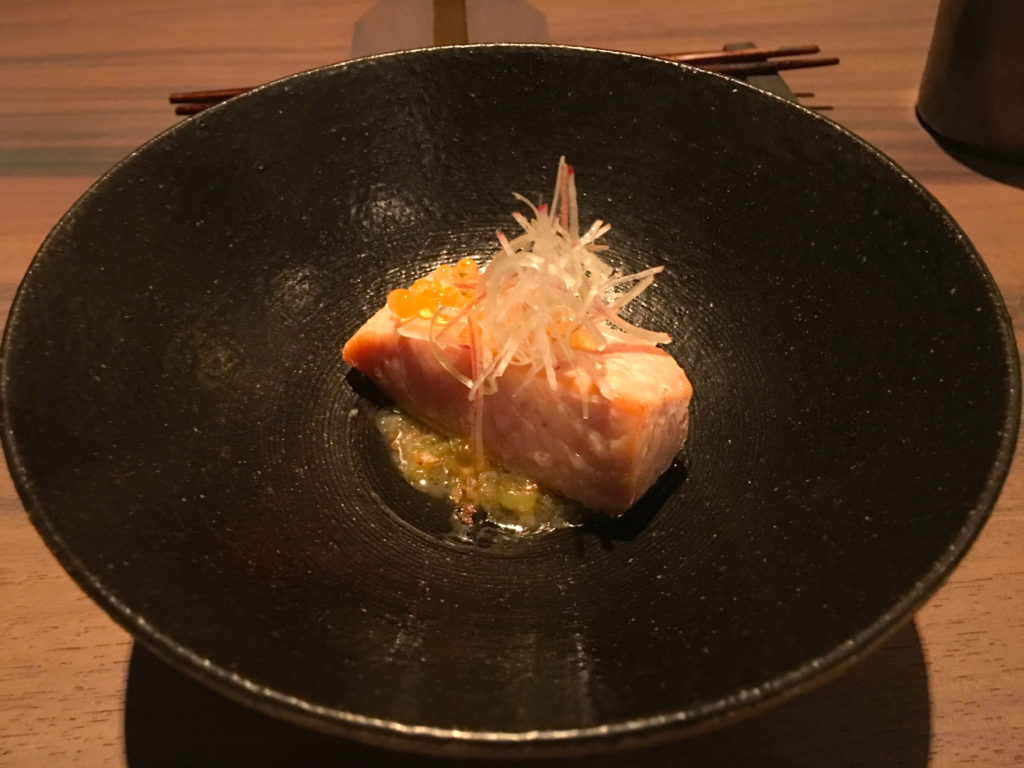 Wild steelhead smoked in a Ibushi-gin, which is a donabe smoker, was our third main dish. It was soft and perfectly cooked, perhaps first sous vide then smoked. It was paired with a salt koji vinaigrette, trout roe, toasted pine nuts, and topped with jullienned myoga.
Wild steelhead smoked in a Ibushi-gin, which is a donabe smoker, was our third main dish. It was soft and perfectly cooked, perhaps first sous vide then smoked. It was paired with a salt koji vinaigrette, trout roe, toasted pine nuts, and topped with jullienned myoga.
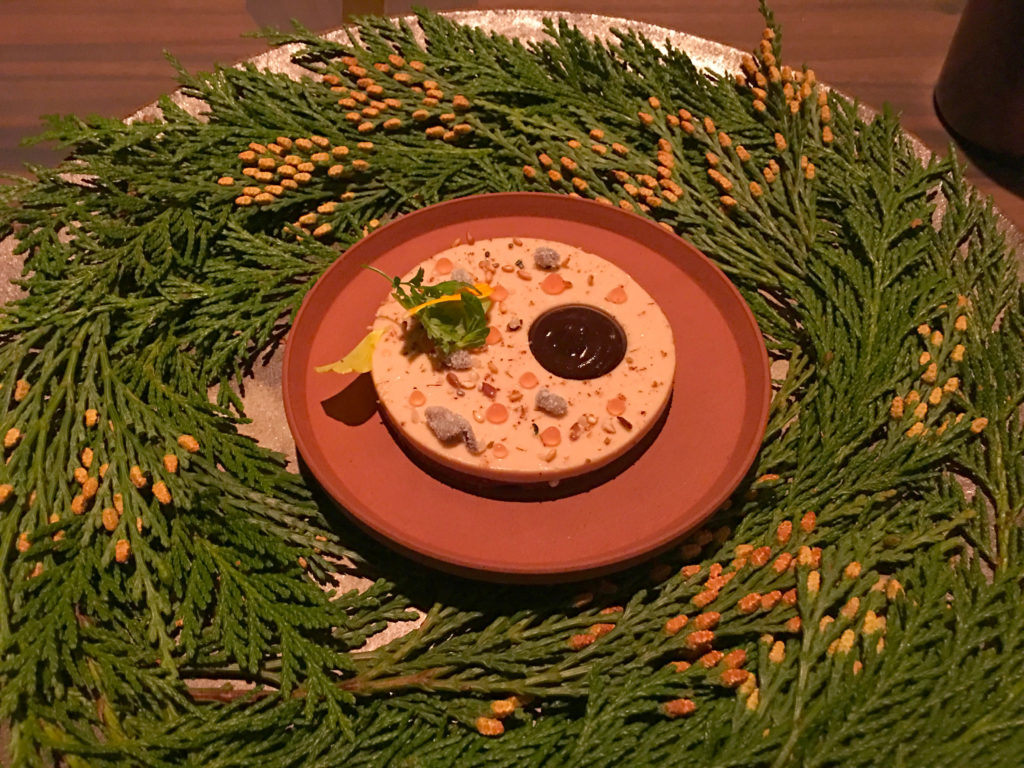 Our fourth main dish was cured foie gras on top of a thin sable biscuit and paired with sugar plums and rooibos tea to help cut the fattiness and finished with trout roe. The plating was conifer branches that gave a nice pine smell to complement the dish. The dish was both rich in flavor yet delicate. A nice Yin/Yang balance.
Our fourth main dish was cured foie gras on top of a thin sable biscuit and paired with sugar plums and rooibos tea to help cut the fattiness and finished with trout roe. The plating was conifer branches that gave a nice pine smell to complement the dish. The dish was both rich in flavor yet delicate. A nice Yin/Yang balance.
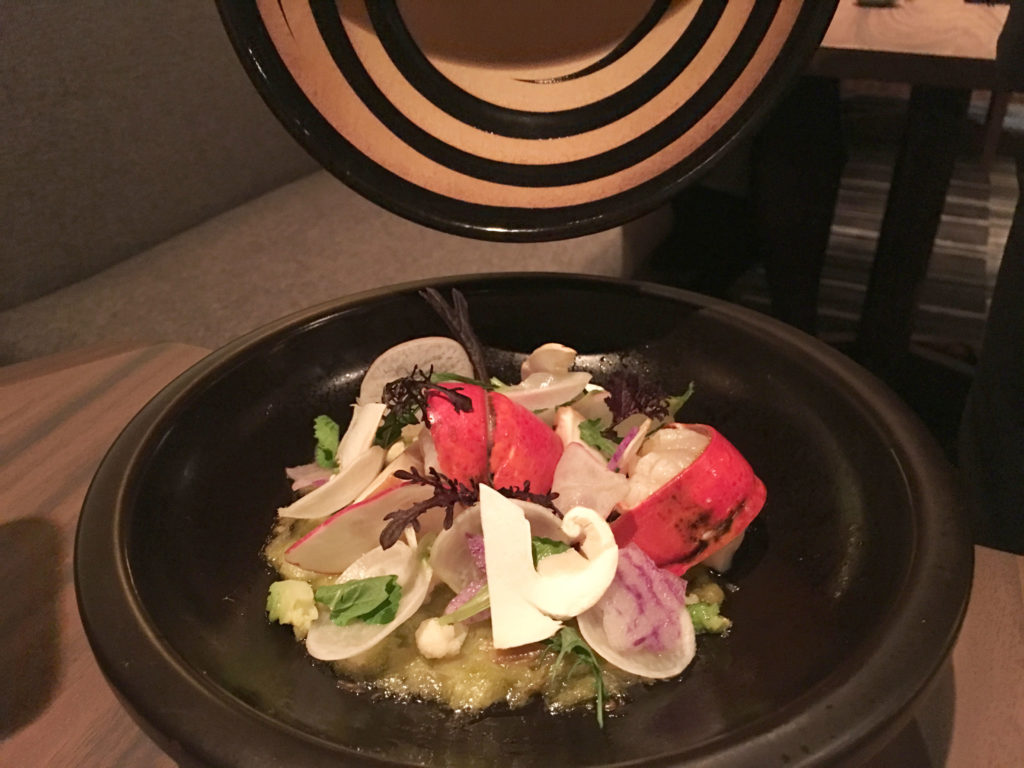 Next, we were presented with a closed Fukkura-san, which is another donabe that is tagine shaped as our fifth main dish. In it was matsutake, lobster, shaved daikon and radish, and other vegetables. They were still raw, but it was awesome for them to showcase the Fukkara-san and it’s contents to use before cooking and plating.
Next, we were presented with a closed Fukkura-san, which is another donabe that is tagine shaped as our fifth main dish. In it was matsutake, lobster, shaved daikon and radish, and other vegetables. They were still raw, but it was awesome for them to showcase the Fukkara-san and it’s contents to use before cooking and plating.
After cooking the item, it was again beautifully presented to us. The lobster and matsutake was perfectly cooked. I love the cedar and earthy taste of the matsutake mushrooms and it goes surprisingly well with the lobster. The sauce was a leak puree.
Our sixth main dish was Saddle of Lamb from the Heart. You can see right away from the color of the lamb that it was perfectly cooked and it was moist and tender. Even more amazing is the layer of fatty skin that is so soft and flavorful. The gameness of the lamb was tempered when you eat it with the pickled carrots, turnip greens, hazelnut, and apricot.
Our last of the main dish was focused on Sonoma grains, which was mainly farro. It had crispy bites of fatty lamb and topped with white truffle and various herbs that I believe was from their garden. The au jus of the lamb is poured in as the sauce. A rich and savory dish that probably is further enhanced by three shavings of winter white truffles that elevates the dish.
Next we had our dessert courses and there was a quite a few courses. The first was a satsuma (type of tangerine) granite. The frozen juice was refreshing and paired with beautifully shaved fuyu persimmons and dusted with matcha powder. At the bottom was a matcha/chocolate-like cookie crumble for texture and some cream for the sauce.
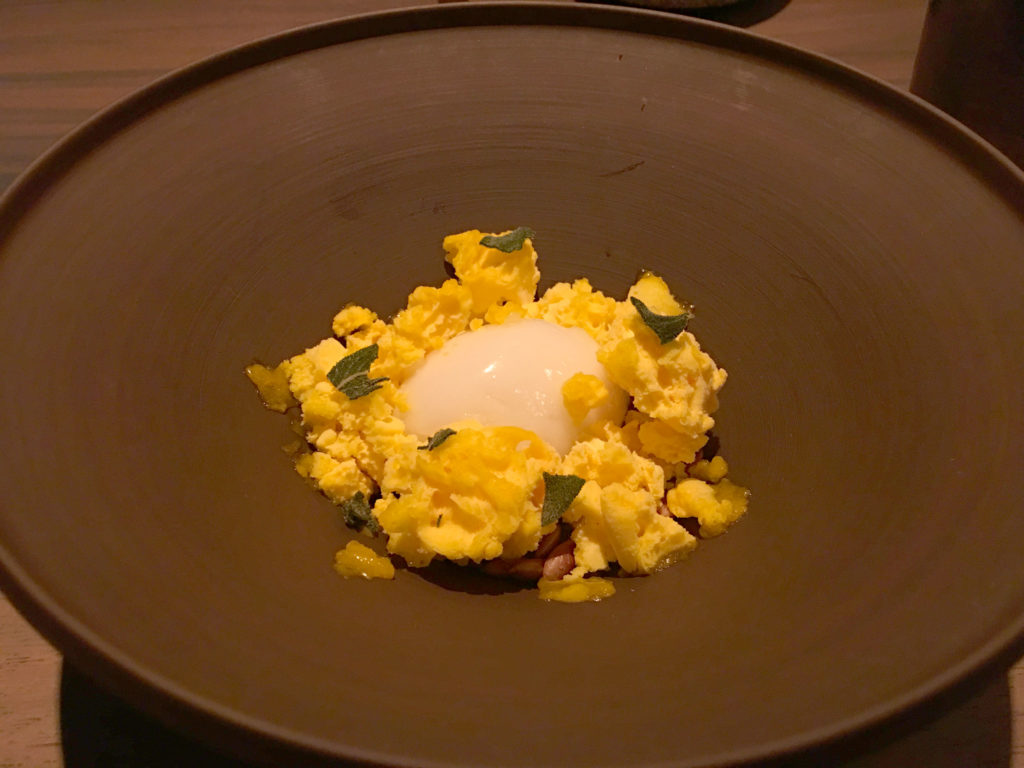 Our next dessert looked like a play on a poach egg in the center and surrounded by a scrambled egged was actually a Kobacha (Japanese pumpkin) sorbet on the outside and a pear, sage and cardamom frozen compote. There was also roasted pepitas at the bottom for texture and a nutty taste.
Our next dessert looked like a play on a poach egg in the center and surrounded by a scrambled egged was actually a Kobacha (Japanese pumpkin) sorbet on the outside and a pear, sage and cardamom frozen compote. There was also roasted pepitas at the bottom for texture and a nutty taste.
Our last dessert was their Wagashi course. Wagashi are traditional Japanese sweets usually served with Tea. Here we get three items on a beautiful stand.
An amazing single bite was a white chocolate shell that you put the whole bite in your mouth and it would burst as it melts with hojicha and yuzu cold crystals that instantly became liquid. すごい/OMG! Amazing way to use nitrogen in a dessert.
Cara cara orange pulp showed up again and paired with a roasted sweet potato jelly at the bottom that was sweet. It felt like a citrusy and light dessert.
Finally a beautiful blue egg in a nest. It looked like a little birds next you would find on the field.
As we took a bite, we found the inside had fudge and adzuki paste.
With the Wagashi, our amazing dinner comes to an end. From first bite to the last bite, everything was simply すごい/OMG! It was a great way to wrap up 2016 and bring on the new year.
If you like this article, sign up for my Facebook or twitter feed located in the menu page you can click on top of the screen to subscribe. Also we recently set up a forum page to talk about all things tabemono including this article.
